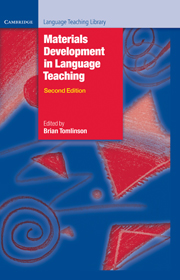Book contents
- Frontmatter
- Contents
- Preface
- Glossary of basic terms for materials development in language teaching
- Acknowledgements
- 1 Introduction: principles and procedures of materials development
- Part A Data collection and materials development
- 2 Using corpora in the language classroom
- 3 Concordances in the classroom without a computer: assembling and exploiting concordances of common words
- 4 Telling tails: grammar, the spoken language and materials development
- Comments on Part A
- Part B The process of materials writing
- 5 A framework for materials writing
- 6 Writing course materials for the world: a great compromise
- 7 How writers write: testimony from authors
- Comments on Part B
- Part C The process of materials evaluation
- 8 The analysis of language teaching materials: inside the Trojan Horse
- 9 Macro- and micro-evaluations of task-based teaching
- 10 What do teachers really want from coursebooks?
- 11 The process of evaluation: a publisher’s view
- Comments on Part C
- Part D The electronic delivery of materials
- 12 Developing language-learning materials with technology
- 13 New technologies to support language learning
- Comments on Part D
- Part E Ideas for materials development
- 14 Seeing what they mean: helping L2 readers to visualise
- 15 Squaring the circle – reconciling materials as constraint with materials as empowerment
- 16 Lozanov and the teaching text
- 17 Access-self materials
- Comments on Part E
- Conclusions
- Recommended reading
- Index
17 - Access-self materials
Published online by Cambridge University Press: 09 February 2023
- Frontmatter
- Contents
- Preface
- Glossary of basic terms for materials development in language teaching
- Acknowledgements
- 1 Introduction: principles and procedures of materials development
- Part A Data collection and materials development
- 2 Using corpora in the language classroom
- 3 Concordances in the classroom without a computer: assembling and exploiting concordances of common words
- 4 Telling tails: grammar, the spoken language and materials development
- Comments on Part A
- Part B The process of materials writing
- 5 A framework for materials writing
- 6 Writing course materials for the world: a great compromise
- 7 How writers write: testimony from authors
- Comments on Part B
- Part C The process of materials evaluation
- 8 The analysis of language teaching materials: inside the Trojan Horse
- 9 Macro- and micro-evaluations of task-based teaching
- 10 What do teachers really want from coursebooks?
- 11 The process of evaluation: a publisher’s view
- Comments on Part C
- Part D The electronic delivery of materials
- 12 Developing language-learning materials with technology
- 13 New technologies to support language learning
- Comments on Part D
- Part E Ideas for materials development
- 14 Seeing what they mean: helping L2 readers to visualise
- 15 Squaring the circle – reconciling materials as constraint with materials as empowerment
- 16 Lozanov and the teaching text
- 17 Access-self materials
- Comments on Part E
- Conclusions
- Recommended reading
- Index
Summary
Introduction
Nowadays a lot of self-access materials are available on the Web, as well as on computers and DVDs in self-access centres (see Chapters 12 and 13 of this volume). Some of these materials offer experience of language in authentic use and some set the learners authentic tasks. Nevertheless, the stereotypical image of self-access materials is still of practice exercises which enable the learners to work on what they need in their own time and at their own pace without reference to a teacher. Such materials attempt to achieve the desirable objective of learnercentred, learner-invested activity. Typically they are used to supplement (or even replace) classroom learning activities and usually they focus on providing practice in the use of specific language items or language skills which are problematic for the students. Thus, in an ELTJ article the authors asserted that:
we remain convinced of the value of single-focus material for selfaccess learners who have been trying to identify their particular problems and who are keen to improve their ability in specific points of language. (Lin and Brown 1994)
The development of such materials and their attractive accessibility in learning centres or learning packages remains a positive feature of foreign language-learning pedagogy. However, the main strength of selfaccess materials has often been their main weakness too. In order to make sure that learners can work entirely on their own and still receive useful feedback, there has often been a limiting tendency to restrict the activities to those which can most easily be self-marked by the learners themselves. Thus, although there are notable exceptions, most selfaccess materials still consist of controlled or guided practice activities which use cloze, multiple choice, gap-filling, matching and transformation activities to facilitate self-marking and focused feedback. Such activities can usefully contribute to the development of explicit declarative knowledge (i.e. conscious knowledge of the forms, meanings and systems of the language). But their predominance has meant for many learners that their experience of self-access materials has been restricted to basically closed activities requiring a narrow left brain focus and little utilisation of prior personal experience, of the brain’s potential learning capacity or of individual attributes or inclinations.
- Type
- Chapter
- Information
- Materials Development in Language Teaching , pp. 414 - 432Publisher: Cambridge University PressPrint publication year: 2011
- 6
- Cited by

